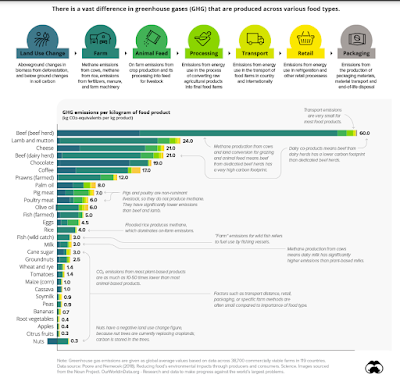The quantity of greenhouse gases generated
by our food can vary considerably across the global food supply chain.
The difference types of food we could
eat can have a significant impact on greenhouse gases emissions on the
environment.
Across all foods, the land use and farm stages of the supply chain account for 80% of the emissions.
On the other end of the spectrum is transportation. This stage of the supply chain makes up 10% of total emissions on average.
Worldwide, there are approximately 13.7 billion metric tons of carbon dioxide equivalents (CO2e) emitted through the food supply chain per year. Unsurprisingly, beef and other animal products have considerably greater effect on emissions.
For example, one kilogram (kg) of beef results in 60 kg of GHG emissions, making beef the greatest contributor to greenhouse gases. In contrast, the same weight of apples produces less than one kilogram of greenhouse gases emissions.
When it comes to plant-based foods,
chocolate is among the highest GHG emitters. One kilogram of chocolate produces 19
kg of greenhouse gases. On average, emissions from plant-based foods are 10
to 50 times lower than animal-based types.

No hay comentarios:
Publicar un comentario